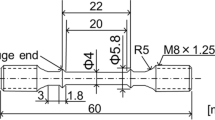Abstract
The effect of Ti content on the creep properties and microstructures of experimental Ni-base single crystal superalloys has been investigated. The experimental alloys were designed to provide better high temperature properties than the commercial single crystal alloy CMSX-4. The creep properties of the experimental alloys, Alloy 2 and Alloy 3, were superior to those of CMSX-4. Alloy 3 showed a longer creep life than Alloy 2 at 900 °C and 950 °C, while it has similar creep life with Alloy 2 at 982 °C. Transmission electron microscopy micrographs of the experimental alloys after the creep test showed distinct deformation features as a function of temperature and Ti content. The dissociation of dislocations into partial dislocations with stacking faults in Alloy 3 was found to improve resistance to creep deformation at 950 °C. The effect of Ti on the creep deformation mechanism was not evident at 982 °C, which resulted in similar creep properties in both experimental alloys. The transition of the γ′ cutting mechanism from dislocations coupled with stacking faults to anti-phase boundary coupled pairs occurred both in Alloy 2 and Alloy 3. However, the transition temperature was higher in Alloy 3 than in Alloy 2 because of the difference in Ti contents.
Similar content being viewed by others
References
J. H. Gu, C. H. Sung, J. H. Shin, S. M. Seo, and J. H. Lee, Korean J. Met. Mater. 54, 261 (2016).
J. S. Lee, S. H. Kwon, B. G. Yoon, B. M. Chang, Y. G. Jung, and J. H. Lee, Korean J. Met. Mater. 54, 838 (2016).
R. Hashizume, A. Yoshinari, T. Kiyono, Y. Murata, and M. Morinaga, Superalloys 2004 (eds. K. A. Green, T. M. Pollock, H. Harada, T. E. Howson, R. C. Reed, J. J. Schirra, et al.), p. 53, TMS, Warrendale, USA (2000).
Y. Koizumi, T. Kobayashi, T. Yokogawa, J. Zhang, M. Osawa, M. Arai, et al. Superalloys 2004 (eds. K. A. Green et al.), p. 35, TMS, Warrendale, USA (2000).
M. Zietara, S. Neumeier, M. Göken, and A. Czyrska-Filemonowicz, Met. Mater. Int. 23, 126 (2017).
T. Kobayashi, Y. Koizumi, H. Harada, and T. Murakumo, Acta Mater. 52, 3737 (2004).
J. X. Zhang, T. Murakumo, H. Harada, and Y. Koizumi, Scripta Mater. 48, 287 (2003).
R. A. Hobbs, L. Zhang, C. M. F. Rae, S. Tin, A. K. Koul, and G. H. Gessinger, Mat. Sci. Eng. A 489, 65 (2008).
C. Tian, G. Han, C. Cui, and X. Sun, Mater. Design 64, 316 (2014).
J. H. Zhang, T. Jin, Y. B. Xu, Z. Q. Hu, and X. Wu, J. Mater. Sci. Tech. 18, 159 (2002).
S. Ochiai, Y. Oya, and T. Suzuki, Acta Metall. Mater. 32, 289 (1984).
G. N. Maniar and J. E. Bridge, Metallography 5, 91 (1972).
Y. F. Wen, J. Sun, and J. Huang, T. Nonferr. Metal. Soc. 22, 661 (2012).
H. P. Wang, M. Sluiter, and Y. Kawazoe, Mater. T. JIM 40, 1301 (1999).
X. P. Tan, J. L. Liu, T. Jin, Z. Q. Hu, H. U. Hong, C. Y. Jo, et al. Mat. Sci. Eng. A 528, 8381 (2011).
G. R. Leverant and B. H. Kear, Metall. Mater. Trans. B 1, 491 (1970).
C. M. F. Rae, N. Matan, and R. C. Reed, Mat. Sci. Eng. A 300, 125 (2001).
T. Link and M. Feller-Kniepmeier, Metall. Mater. Trans. A 23, 99 (1992).
R. C. Reed, The Superalloys, pp.65–73, Cambridge University Press, Cambridge, UK (2006).
W. W. Milligan and S. D. Antolovich, Metall. Mater. Trans. A 22, 2309 (1991).
L. Remy and A. Pineau, Mater. Sci. Eng. 36, 47 (1978).
S. Tian, B. Qian, Y. Su, H. Yu, and X. Yu, Mater. Sci. Forum 706-709, 2474 (2012).
T. Kruml, B. Viguier, J. Bonneville, and J. L. Martin, Mat. Sci. Eng. A 234-236, 755 (1997).
J. S. Huo, J. T. Gou, L. Z. Zhou, X. Z. Qin, and G. S. Li, J. Mater. Eng. Perform. 16, 55 (2007).
G. Bruno and H. C. Pinto, Superalloys 2004 (eds. K. A. Green, T. M. Pollock, H. Harada, T. E. Howson, R. C. Reed, J. J. Schirra, et al.), p. 837, TMS, Warrendale, USA (2000).
Author information
Authors and Affiliations
Corresponding author
Rights and permissions
About this article
Cite this article
Choi, B.G., Kim, I.S., Hong, H.U. et al. Effect of Ti content on creep properties of Ni-base single crystal superalloys. Met. Mater. Int. 23, 877–883 (2017). https://doi.org/10.1007/s12540-017-7089-7
Received:
Accepted:
Published:
Issue Date:
DOI: https://doi.org/10.1007/s12540-017-7089-7




